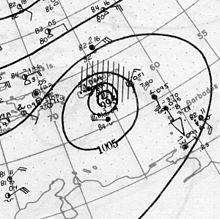
Back Huracà d'Okeechobee de 1928 Catalan Okeechobee-Hurrikan (1928) German Huracán San Felipe II Spanish Okeechobeen hurrikaani Finnish Ouragan Okeechobee French Uragano Okeechobee Italian オキーチョビー・ハリケーン Japanese Taufan Okeechobee 1928 Malay 1928 ਔਕੀਚੋਬੀ ਤੁਫ਼ਾਨ Punjabi Huragan Okeechobee Polish
 Surface weather analysis of the storm nearing Puerto Rico as a Category 5 hurricane on September 13 | |
| Meteorological history | |
|---|---|
| Formed | September 6, 1928 |
| Dissipated | September 21, 1928 |
| Category 5 major hurricane | |
| 1-minute sustained (SSHWS/NWS) | |
| Highest winds | 160 mph (260 km/h) |
| Lowest pressure | ≤929 mbar (hPa); ≤27.43 inHg |
| Overall effects | |
| Fatalities | 4,112+ |
| Damage | $100 million (1928 USD) ($1.77 billion in 2018) |
| Areas affected | West Africa, Cape Verde, Lesser Antilles, Guadeloupe, Virgin Islands, Puerto Rico, The Bahamas, Florida, Georgia, East Coast of the United States, Northeastern United States, Eastern Canada |
| IBTrACS | |
Part of the 1928 Atlantic hurricane season | |
The Okeechobee hurricane of 1928, also known as the San Felipe Segundo hurricane, was one of the deadliest hurricanes in the recorded history of the North Atlantic basin, and the fourth deadliest hurricane in the United States, only behind the 1900 Galveston hurricane, 1899 San Ciriaco hurricane, and Hurricane Maria. The hurricane killed an estimated 2,500 people in the United States; most of the fatalities occurred in the state of Florida, particularly in Lake Okeechobee. It was the fourth tropical cyclone, third hurricane, the only major hurricane of the 1928 Atlantic hurricane season, and remains the deadliest disaster in Florida’s history to date.[1] It developed off the west coast of Africa on September 6 as a tropical depression, but it strengthened into a tropical storm later that day, shortly before passing south of the Cape Verde islands. Further intensification was slow and halted late on September 7. About 48 hours later, the storm strengthened and became a Category 1 hurricane on the Saffir–Simpson hurricane wind scale. Still moving westward, the system reached Category 4 intensity before striking Guadeloupe on September 12, where it brought great destruction and resulted in 1,200 deaths. The islands of Martinique, Montserrat, and Nevis also reported damage and fatalities, but not nearly as severe as in Guadeloupe.
Around midday on September 13, the storm strengthened into a Category 5 hurricane and peaked with sustained winds of 160 mph (260 km/h). About six hours later, the system made landfall in Puerto Rico; it remains the only tropical cyclone on record to strike the island at Category 5 intensity. Very strong winds resulted in severe damage in Puerto Rico; 24,728 homes were destroyed and 192,444 were damaged throughout the island, leaving over 500,000 people homeless. Heavy rainfall also led to extreme damage to vegetation and agriculture. On Puerto Rico alone, there were 312 deaths and about US$50 million ($887 million today) in damage. While crossing the island and emerging into the Atlantic, the storm weakened slightly, falling to Category 4 intensity. It began crossing through the Bahamas on September 16, where it resulted in 18 fatalities.
The storm made landfall near West Palm Beach, Florida, early on September 17, with winds of 145 mph (233 km/h). In the city, more than 1,711 homes were destroyed; the effects were most severe around Lake Okeechobee. The storm surge caused water to pour out of the southern edge of the lake, flooding hundreds of square miles to depths as great as 20 feet (6.1 m). Numerous houses and buildings were swept away in the cities of Belle Glade, Canal Point, Chosen, Pahokee, and South Bay, Florida. At least 2,500 people drowned, while damage was estimated at $25 million ($444 million today).[2] The system weakened significantly while crossing Florida, falling to Category 1 intensity late on September 17. It curved north-northeast and briefly emerged into the Atlantic on September 18, but soon made another landfall near Edisto Island, South Carolina, with winds of 85 mph (137 km/h). Early on the following day, the system weakened to a tropical storm and became an extratropical cyclone over North Carolina hours later. Overall, the hurricane caused $100 million in damage ($1774 million today) and killed at least 4,112 people.
- ^ "BIBLIOGRAPHY", Fire in the Big House, Ohio University Press, pp. 263–272, 2019-10-08, doi:10.2307/j.ctv224txkx.22, retrieved 2024-02-21
- ^ "The deadliest disaster to ever happen in each state". MSN. Retrieved 25 April 2023.